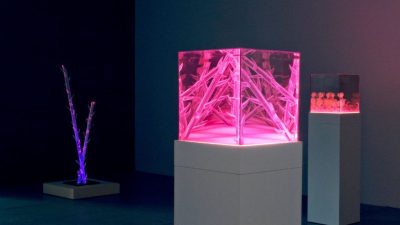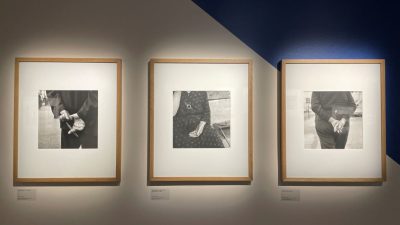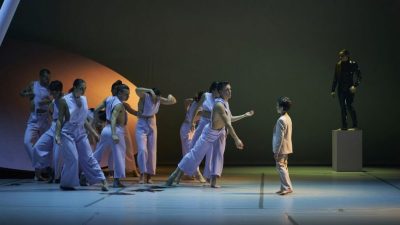Bauhaus: The Style We Have Never KnownThe Bauhaus celebrates its 100th anniversary this year, and here in Hungary, we somehow consider the style our own. In Budapest, there is no end to centennial walking tours, while countless exhibitions on the topic keep opening. But what is Hungary’s connection to this German school, and especially, what is left of its heritage a century later in Hungary, some seven hundred kilometres from the original centre? Do we even know what the Bauhaus style is?
Most people think only of architecture when they hear the name Bauhaus – founded in 1919 in Weimar – when in actual fact it was a school of art that encompassed many subjects. Why do we, in Hungary, feel so connected to it? It may not seem obvious at first. After all, of the more than one thousand students who studied there, only twenty-five were Hungarian, and among the teachers, there were only three. True, each of the latter played an important role in the life of the school.

Otti Berger was a student before she became director of the textile workshop. She was one of the few female instructors, noted even today especially for this reason. Marcell Breuer too was “home-bred”: he was already designing impressive furniture as a student, and went on to create the tubular chairs that became one of the most characteristic products of the Bauhaus. László Moholy-Nagy, known for his photograms, joined the teaching staff in 1923, and later, as the right hand man of director Walter Gropius, he played an important role in completely transforming the system of instruction. But many of the students also created lasting works: Farkas Molnár’s “Red Cube House” became iconic, the drawings of which are in the MoMA’s archives in New York.
The list of names goes on, but we might still ask: “Okay, okay, but what did they bring back home from all this?” Berger perished in Auschwitz; Moholy-Nagy founded a school of design in Chicago; and Breuer, whose ancestry prevented him from working in Hungary, became a renowned architect in America. And so it was the students who imported Bauhaus, and especially its reputation, to Hungary. Their indirect influence was enormous. Sándor Bortnyik not only brought innovation to Hungarian commercial graphic design, but in addition, his private school of graphic art, Műhely (Workshop), taught Victor Vasarely, whose works might be familiar even to those who never attend exhibitions.
During the years of socialism, Bauhaus was not looked upon kindly, and so in the 1960s, artists had to discover it all over again. Sealed off from Western masters and collections, they sometimes attempted to reconstruct the three-dimensional creations from illustrated books. Of course, the influence did not simply mean copying. Since then, it is rediscovered in almost every decade, and artists try to create according to original Bauhaus principles. The big question is: what can Moholy-Nagy’s light modulator or Andor Weininger’s Spherical Theatre offer in the age of computer-enhanced arts? The Ludwig Museum’s exhibition, Bauhaus100: A Programme for Today, searches for the answer to this very question. It shows how the Bauhaus approach affected Hungarian artists over the last fifty years, and where its influence can be detected even today.
Of course, in Hungary this influence is found not primarily in the fine arts, but in architecture. Or rather: in our image of architecture. Although we have a Bauhaus quarter (Újlipótváros) and a Bauhaus Ring (Margit körút), in reality, these places have no actual Bauhaus buildings. The few architecture students that returned to Hungary received hardly any commissions, and often created lasting works in other styles, such as Farkas Molnár’s unfinished Hungarian Holy Land Church. At the same time, in Hungary, the modern style that began around that time almost completely fused with the school’s name; moreover, it is often lumped together with the Streamline Moderne of the Art Deco style. Geometric forms, white walls, and vast glass surfaces are now synonymous with Bauhaus, although originally it was not a uniform art style, but rather, more of a world view, an approach to life.
Indeed, a Hungarian art historian, Ernő Kállai had already called it an architectural style in 1930, but the expression did not become widely used in Budapest until after the change of regime in 1989. Bauhaus was the common term for buildings that, though modern, angular, and flat roofed, were not built in the socialist era, and particularly not in the character of that era – typified by mass-production and construction. Real estate agents also began to use the word when seeking to emphasize the quality of the offered apartment, in addition to photographers, bloggers, journalists, and enthusiastic city lovers, who wondered at the beauties of early modernism. In the end, whatever we call them, the city contains real treasures of modernism which still don’t receive the attention they deserve, and so we have a chance to delve into the mystery of Bauhaus during this year’s Budapest Spring Festival.
Author: Dávid Zubreczki
This article was first published in the BSF Magazine.
THE EDITOR RECOMMENDS – Symphony Orchestra in a Modernist Airport
A wonderful example of the extension of modernism between the two world wars is the Ferihegy Airport building (presently known as Budapest Airport Terminal 1), designed by Károly Dávid Jr. Dávid gained experience not at the Bauhaus school, but at another important intellectual workshop of the era, Le Corbusier’s studio in Paris. He won the competition announced for a new airport in 1939 with an entry reminiscent of an aircraft, in which the waiting area was the fuselage, the service areas were the wings, while the two towers represented the two propellers. Although the half-finished building was destroyed in the war, later it was rebuilt according to his design. It was inaugurated in 1950, although the reconstruction was not fully complete until the end of the 1950s. By then, Dávid had finished the most important work of his career, the (recently demolished) People’s Stadium. The former airport’s building, authentically restored in 2005, operates today as a venue for many events: on 12 April the Kodály Philharmonic Debrecen will perform here. This is especially exciting because the orchestra’s conductor, Dániel Somogyi-Tóth, is an aviation aficionado himself, and among other things, is one of the founders of the civil organization that develops the Aeropark aircraft museum next door. Additionally, the evening’s guest performer, violinist Kristóf Baráti, already has more than 150 hours of flight time by way of earning his pilot’s license.
April 9 | 6 pm
Ludwig Museum – Museum of Contemporary Art
Bauhaus100. A Programme for the Present
The exhibition is on view between 10 April and 25 August.
THE EDITOR RECOMMENDS
April 12 | 7.30 pm
Ferenc Liszt International Airport Terminal 1
Kristóf Baráti (violin) and the Kodály Philharmonic Debrecen
Fire – Water – Earth – Air
Conductor: Dániel Somogyi-Tóth




























Comments
1 Responses to “Bauhaus: The Style We Have Never Known”
NIce style! Very modern and cool. Thanks!